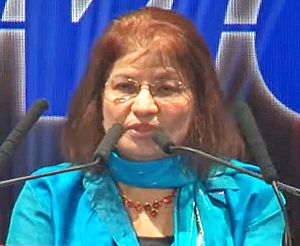Pratibha Gai facts for kids
Quick facts for kids
Dame Pratibha Gai-Boyes
|
|
|---|---|

Pratibha Gai at The Asian Awards in 2016
|
|
| Born |
Pratibha Laxman Gai
|
| Alma mater | University of Cambridge |
| Awards |
|
| Scientific career | |
| Institutions | |
| Thesis | Applications of Weak Beam Electron Microscopy (1974) |
Dame Pratibha Laxman Gai-Boyes DBE FRS HonFRMS FRSC FREng is a British scientist who studies tiny things using special microscopes. She is a Professor of Electron Microscopy at the University of York. She is famous for inventing a special microscope called the atomic-resolution environmental transmission electron microscope (ETEM). This amazing tool helps scientists see chemical reactions happening at a super tiny level. Dame Pratibha also strongly supports women who want to work in science.
Early Life and Education
Pratibha Gai grew up in India. As a child, she loved science and was very curious about how things work. She was inspired by famous scientists like Marie Curie. Her parents also encouraged her to study chemistry.
At that time, it was not common for girls to choose careers in science. Despite this, Pratibha was chosen as a national science talent scholar when she was a teenager. This helped her get scholarships for her studies.
She studied at the University of Cambridge in the UK. In 1974, she earned her PhD. Her research was about using electron microscopes to study materials.
Amazing Discoveries and Career
Dame Pratibha Gai has made huge steps forward in how we use electron microscopes. She co-invented the atomic-resolution environmental transmission electron microscope (ETEM) with Edward D. Boyes. This special microscope lets scientists watch chemical reactions as they happen, right down to the atomic level.
Imagine being able to see atoms moving and changing during a reaction! This helps scientists understand how important chemical processes work. For example, it helps them learn more about how catalysts work. Catalysts are substances that speed up chemical reactions.
Her invention has been very helpful to many scientists around the world. Microscope makers and chemical companies use her ideas and inventions.
In 2009, after many years of hard work, Dame Pratibha successfully created her special microscope. It can see chemical reactions at the atomic scale. Before this, regular microscopes could only look at materials in a vacuum, which is like a "dead" condition. Her ETEM can see things happening in real-time, with gases present.
She worked with colleagues to build and improve this machine for over twenty years. She started with an earlier version when she was a researcher at the University of Oxford. She also spent 18 years working in the US at a company called DuPont and at the University of Delaware.
Even though her microscope is incredibly valuable, she decided not to patent it. She explained that if she patented it, other scientists might not be able to use it easily. She wanted many researchers to use her invention to create more scientific knowledge. She was more interested in helping science grow than in making money.
Dame Pratibha also speaks out often about the importance of women in science. She knows it can be challenging for women scientists, especially if they have children. She encourages her female students to "aim high" and pursue their scientific dreams.
Awards and Recognition
Dame Pratibha Gai has received many important awards for her work:
- In 2010, she received the Gabor Medal and Prize for her work on the ETEM.
- She became a Fellow of the Institute of Physics in 2016.
- She also became a Fellow of the Royal Society of Chemistry in 2016.
- In 2013, she won the L'Oréal-UNESCO Awards for Women in Science for Europe.
- She was made a Fellow of the Royal Academy of Engineering in 2014.
- In 2016, she became a Fellow of the Royal Society, which is a very high honor for scientists.
- In 2018, she received The Asian Awards for her amazing achievements in science and technology.
- Also in 2018, she was made a Dame Commander of the Order of the British Empire (DBE). This honor was for her contributions to chemical sciences and technology.
- She became an Honorary Fellow of the Royal Microscopical Society in 2018.
See also
 In Spanish: Pratibha Gai para niños
In Spanish: Pratibha Gai para niños

